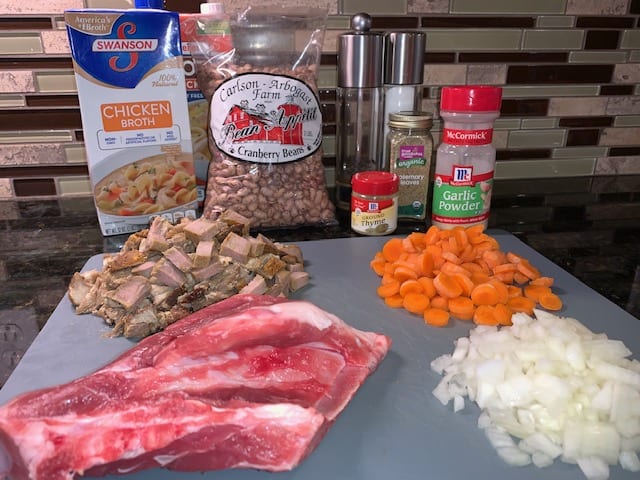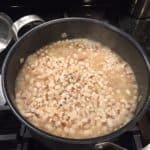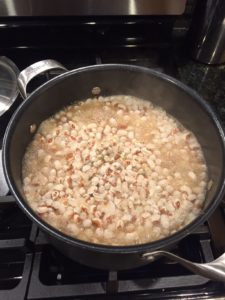Every November we head up to deer camp for a couple of days, in search of that big buck. After a long day of hunting, it’s always good to have a nice hot meal. Each of us brings a pot of chili or soup for a night’s dinner. My contribution for the last several years has been this easy ham and bean soup recipe I really like.
A good friend of mine shared a method his family uses for cooking their bean soup. Instead of soaking the dried beans prior to cooking, you add them to the pot dry and cook them till tender. It does increase the cooking time some, but the beans absorb all those wonderful flavors, from the other ingredients, as they’re cooking
You can use your favorite kind of bean or experiment. I’ve used yellow eye beans and cranberry beans. Both are great in this bean soup recipe. I have to admit, I’m a little partial to the yellow eye beans. They are very well known in the south, but a little harder to find in the north. If you ever come across some shopping, buy a bag and give them a try! If you can’t find them near you, click the link above and give them a try.

This ham and bean soup recipe is delicious as is, but you can try adding other ingredients, like celery or fennel, to make it your own. I’ve been using a venison ham I had locally made by an Amish meat processor. It’s perfect for this soup and one of the ways I’ve made it my own. By the way, it’s not just for hunt camp!
Slow-cooker Ham and Bean Soup
As mentioned above, I’m a real fan of putting the beans in dry and cooking them slowly. So I decided to try the exact same recipe only cooking it in the slow-cooker. It turned out great. It extended the cooking time, but that’s what “slow-cookers” are all about. The best part was the process was a lot less “hands-on”. Once it’s in the slow-cooker just check it every couple hours, and give it a little stir, and you’re good to go.
On the recipe card below, I recommended starting with only 2 cups of water and I thought it turned out about perfect for my taste. I believe there was a little less evaporation. But the consistency is all about personal preference, so once you get close to being finished you can add more water as desired.

- 3 Cups Beans, dried (1-1/2 pounds)
- 1 Pound Ham Diced
- 1 each Ham or pork bone (optional)
- 1 Cup Carrots Chopped
- 1 Medium Onion Chopped
- 64 Ounces Chicken broth (2 – 32-ounce containers)
- 3 Cups Water
- ½ Tsp Garlic powder
- ½ Tsp Thyme
- 1 Dash Salt and pepper To taste
- ½ Tsp Rosemary
- Add ham, carrots, and onions to the bottom of a 6-quart pot; on medium heat. Brown the ham and begin cooking carrots and onion. (The carrots can be added an hour before serving if you like them firm)

Add chicken broth, water, spices, dry beans, and ham/pork bone, if used, to the pot and bring it to a boil. (If you like a thicker soup, start with 2 cups of water and add the rest later, as needed.)
- Bring the soup to a boil, then reduce it to a simmer and cover
- Allow the soup to simmer for 2 to 3 hours, stirring occasionally, until beans are tender. The cooking time can vary depending on the type of bean used and the consistency you like.
- Add water, as the beans simmer and absorb the liquid, to maintain the consistency you desire.
Add chicken broth, water (2 cups only), spices, dry beans, and ham/pork bone, if used, to the slow-cooker and turn on high.
Brown the ham and begin cooking carrots and onion. (The carrots can be added a couple hours before serving if you like them firm)
Add the browned ham, carrots and onions to the slow-cooker and cook on high for about 5 hours. Stir every couple hours.
Add water near the end of the cooking time to get the consistency you desire. I found the 2 cups were enough, but this could vary with the type of cooker and your personal preference. Enjoy!
Final Thoughts
This soup is delicious and goes great with a slice of homemade bread, cornbread, or biscuits. It’s perfect for those cool fall days or cold winter nights. Give this slow-cooked ham and bean soup recipe a try. I’m sure you’ll love it.

If you have any comments or questions, you can leave them in the comments section below or you can email us at [email protected]. FYI, we do not collect or share email addresses. We will only use them to reply to your comments or provide answers to your questions. We are also required to let you know that some of our links are “affiliate links”. This means if you click on a link and make a purchase, we could make a small commission, at no extra cost to you. This helps offset the cost of maintaining our website. So, if you like what you’ve seen, please be sure to give us a “Like” and “Share” on Facebook and Instagram too. Thank you for reading and good luck with all your home projects!


